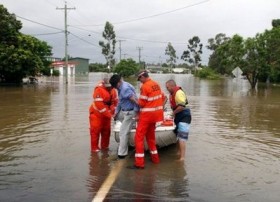 North-eastern Australia’s worst flooding in decades is continuing to cause chaos across the region.
North-eastern Australia’s worst flooding in decades is continuing to cause chaos across the region.
Around 1,000 people in Queensland have been evacuated, including the entire population of the town of Theodore.
The government has declared Theodore and two other towns in the region to be disaster zones, and forecasters say the floods have not yet peaked.
The cost of the damage is expected to top A$1bn (£650m), including massive losses of sunflower and cotton crops.
Army Black Hawk helicopters evacuated the 300 residents of Theodore, where every building in the town apart from the police station has been flooded, local media reported.
The town’s river has risen more than 50cm (20in) above its previous recorded high, Emergency Management Queensland spokesman Bruce O’Grady told Australia’s ABC News.
In the southern Queensland city of Bundaberg, residents in some areas were being advised to leave their homes as the Burnett River rose to danger levels.
The river was expected to reach 7.5m (24ft), about 0.3m (1ft) more than the previous high water record of 1954.
In the Central Highlands town of Emerald, flooding forced the closure of the main bridge, cutting the town off, Australian media reported.
Brad Carter, the mayor of Rockhampton, warned that his city and more remote surrounding communities could be cut off by the weekend.
The floods are also hitting businesses in Queensland, which is Australia’s key coal-producing state.
Two of Australia’s biggest coal export terminals – Dalrymple Bay and Gladstone Ports – together with Australia’s top coal transporter QR National said they were cutting back on operations while the floods persisted.
Rio Tinto Group, the world’s third-largest mining company, declared “force majeure” at four Queensland coal mines allowing it to miss deliveries because of circumstances beyond its control.
Disaster fund
Inland towns such as Chinchilla and Dalby are all under water; the nearby town of Warra, and the towns of Alpha and Jericho, west of Emerald, have also been declared disaster zones, with hundreds of homes flooded or at risk.
Media reports said Dalby was running low on drinking water supplies after its water treatment plant was damaged by the floods.
Queensland Premier Anna Bligh launched a disaster relief fund with A$1m (£657,000) in state money and Australian Prime Minister Julia Gillard pledged to match the amount with federal funds.
The state capital, Brisbane, has recorded its wettest December in more than 150 years. Cyclone Tasha, which hit Queensland on Saturday, also brought torrential rain to the state.
Queensland Premier Anna Bligh, centre, met evacuated residents in Bundaberg
Further south, in New South Wales, about 175 people who had spent the night in evacuation centres have returned home.
But 800 people in the towns of Urbenville and Bonalbo are expected to be cut off for another 24 hours.
While the rain is now easing, water is continuing to flow from sodden land across central and southern Queensland into already swollen rivers, adds our correspondent.
Australia’s Emergency Services Minister Neil Roberts told ABC the worst was yet to come.
Farming groups says the floods could devastate crops, badly hitting an industry which was already suffering the effects of a lengthy drought.
Cotton Australia said that about 7,500 hectares of the crop planted near Theodore had been destroyed.
[adrotate group=”8″]
